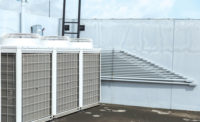Often, an HVAC system is designed by the selection of individual components and not by a whole-system approach. This has become common practice for mechanical engineers, usually resulting in poor system performance and very inefficient HVAC systems. One of the disadvantages of the component approach manifests itself in the equipment manufacturers selecting motors for pumps and fans to operate at speeds in excess of the rated 60 Hz, without consideration of the effect on the whole system.
Manufacturers are selecting pumps and fan motors sized at up to 25% less than the basis of design at times in order to reduce the first cost of their equipment. In some cases, manufacturers are selecting fans and pumps to operate at frequencies up 100 Hz. In order to meet load, these motors must operate at higher-than-designed frequencies. Often, only a detailed review of the equipment submittals during the construction administration phase reveals this less-than-ideal selection. Engineers are faced with the difficult decision of whether or not to approve these submittals without fully understanding the effects on the performance of the designed HVAC systems. They must also deal with very difficult questions, such as, “How does running the motors at higher frequency affect the current, voltage, torque, durability, efficiency, and long-term performance?”
The answers vary with different manufacturers, but commonly the answers depend on the equipment you have it hooked up to, the service factor, and the frequency specification of the motor and equipment. This article will address the benefits of using a system approach to HVAC design, especially with regard to motors, and will also discuss the disadvantages of over-speed imposed on the motors for fans and pumps.
Overview
Recent studies report that more than 25% of the energy consumed in commercial buildings is used for heating, ventilation, and air conditioning. A large portion of this energy (anywhere from 30% to 60%) is consumed by pumps and fans. The most important component for a fan or pump is the electric motor, which allows them to do useful work vital for HVAC processes: moving fluids and air through systems.
Electric motors make up the single largest end use of electricity in the world. Electric motors account for up to 55% of electrical consumption in industrial applications. In process industries, electric motors account for more than 60% of electricity use. Electric motors are common for these applications because they provide efficient, reliable, long-lasting service, and most require relatively little maintenance. Despite these advantages, however, they can be inefficient and costly to operate if they are not properly selected, designed, and maintained. HVAC designers can avoid unnecessary increases in energy consumption, maintenance, and costs by selecting motors that are well suited to their applications and making sure that they are well maintained.
Service Factor
The service factor for a motor is very important when selecting motors for pumps and fans. The service factor is a multiplier that indicates the percentage of horsepower (or other nameplate rating, such as torque) above full load at which a motor can operate without causing a failure under certain conditions. Common service factor values are 1.10 and 1.15. A motor operating continuously at a service factor greater than 1 will have a reduced life expectancy when compared to operating at its rated nameplate horsepower.
Section 230513 – “Common Motor Requirements of HVAC Equipment” of the AIA Masterspec addresses the service factor requirement for motors. Engineers need to make sure that the specification sections for fans and pumps refers to section 230513 for service factor for motor selections. Table 1 shows the recommended National Electrical Manufacturers Association (NEMA) service factor at synchronous speed (RPM) for drip proof motors. By understanding service factor and its relation to motor amps and proper installation conditions, the engineer is able to specify a motor with a long service life.
HVAC Design - System Approach
Mechanical engineers tend to focus on individual equipment selections and forget to analyze how the motor and drive system will operate as part of the whole HVAC system. The common HVAC design approach is to break a system down into disjointed components, optimize the selection of each discrete piece of equipment to suit a particular design condition, and then assemble them all together and declare them a system. The advantage of this method is that it simplifies the design; the disadvantage is that it ignores the important interactions among different components.
On the other hand, a system approach allows the engineer to analyze both the demand and supply sides of the system and how they work together. The engineer evaluates how end-use requirements can be accomplished most effectively and efficiently. Focusing on systems means expanding possibilities, from looking for one piece of equipment that can meet worst-case needs to evaluating whether components can be configured to maintain high performance over the entire range of operating conditions.
An example of where this system approach would be beneficial is in the selection of the fans and pumps for the HVAC system. The engineer is responsible for analyzing the motor selection to ensure meeting not only the peak load but also its most efficient operating range. A typical example is selecting a motor that is most efficient at one-half to full load to operate at less than one-half or into the service factor.
The engineer is required to analyze the calculated loads as well as the energy model to determine how the system will perform throughout the year. This system analysis will inform the design and will help the engineer to select a motor and drive size that will maximize the energy efficiency of the system. Using a component approach will not identify how the motor will be loaded throughout the year and therefore would result in an inefficient motor and drive selection.
A VAV system is one of the most popular air distribution systems for commercial buildings. In this system, a motor-driven fan in an AHU supplies air to several VAV boxes and has an airflow requirement that the system ductwork was designed to handle. The fans are specified according to the requirements of this airflow condition. However, actual operating conditions can vary according to the season, the time of day, and the occupancy pattern for the building.
To handle the need for variable flow rates, the system is equipped with VFDs and dampers. Dampers are one of the least-efficient methods of controlling flow in an HVAC system. However, a damper used in combination with a VFD drive is the most efficient means of operating a VAV system. This is because the motor power use can be better managed by using the VFD to modulate the power consumption based on system load profile. In addition to increasing energy costs, an inefficient motor and drive system often increases maintenance costs. When systems do not operate efficiently, the stress on the system caused by energy losses must be dissipated by piping, structures, dampers, and valves.
Reviewing a submittal – What to look for
A significant amount of effort is focused on design, but that same amount of input is seldom spent on the review of submittals during construction. Typically, graduate engineers are burdened with the task of approving HVAC equipment that they did not select, and they often do not understand what to look for when reviewing the submittal. This construction administration phase should really be regarded the most important part of the equipment selection process. It is in this phase that engineers have the final say on whether the designed equipment will meet the system demand.
It has now become commonplace for manufacturers’ representatives or sales people to reselect the designed equipment in a value engineering exercise orchestrated by owners (or simply to beat the competition). This pressure can result in AHU fans and pumps being selected to run at speeds of up 100 Hz in order to meet the design loads. At that point, any number of project variables make it difficult to sign off on the design with confidence that it will operate with the performance and efficiency intended.
Take, for example, a motor with a service factor of 1 and an FLA of 25, which is being operated at 25 amps and 60 Hz. Increasing the frequency to 65 hertz would over-amp the motor. Changing cycles (Hz) and not changing voltage proportionally will eventually burn up the motor. A VFD changes frequency (Hz) in direct proportion to volts, thus producing variable flows while protecting the motor; this is the principle behind VFD drives. Increasing the frequency output to the motor does not by itself cause the motor to draw more current. Current draw is a function of torque and slip. If the motor torque is enough to keep the slip from increasing, then the current draw will not increase. But increasing the frequency above the motor design point means you begin to lose torque. Therefore if the motor was selected with too low a service factor, it may overload the motor and cause it to fail.
In the past it was common practice for mechanical engineers to build in a 20% “fudge factor” in motor design selection. So if the torque required for a motor design is X ft/lb. at a speed of 1,725 RPM, that would equate to Y Horse Power (HP). Based on the closest available motor size from the manufacturer of the rated HP plus 5% (Y+5%) and the next increment of motor size of HP plus 20% (Y+20%); traditionally, the designer would choose the larger motor (Y+20%) which would equate to a maximum torque 20% more than the design load (X+20%). That practice has all but ceased in the spirit of energy efficiency. So if Y HP is required for the motors and the closest standard size is Y+5% HP, then that would be the motor that will be selected. That means if the motor is operated at more than 5% of the available torque, the motor can no longer perform as designed. The lower torque means more slip, higher slip means more current draw, more current draw means more heat (or over load), and more heat means shorter life.
Additionally, centrifugal loads such as pumps and fans are governed by the fan and pump affinity laws (Figure 1).
Fan Affinity Laws
Volume Capacity
The volume capacity of a centrifugal fan can be expressed as:
q1 / q2 = (n1 / n2)(d1 / d2)3 ………………………….. (1)
Where:
q = volume flow capacity (m3/s, gpm, cfm)
n = wheel velocity - revolution per minute - (rpm)
d = wheel diameter
Head or Pressure
The head or pressure of a centrifugal fan can be expressed like:
dp1 / dp2 = (n1 / n2)2 (d1 / d2)2 ……………………… (2)
Where:
dp = head or pressure (m, ft, Pa, psi, ..)
Power
The power consumption of a centrifugal fan can be expressed as:
P1 / P2 = (n1 / n2)3 (d1 / d2)5 …………………………(3)
Where:
P = power (W, bhp)
Changing the Wheel Velocity
If the wheel diameter is constant - change in fan wheel velocity can simplify the affinity laws to:
Volume Capacity
q1 / q2 = (n1 / n2) …………………………………..(1a)
Head or Pressure
dp1 / dp2 = (n1 / n2)2 …………………………. (2a)
Power
P1 / P2 = (n1 / n2)3 ……………………………(3a)
From the simplified equation for a centrifugal load, the following is true:
• Change in flow is proportional to the change in shaft speed
• Change in head (pressure) is proportional to the square of the change in shaft speed
• Change in power consumed is proportional to the cube of the change in shaft speed
For a VFD application, the alternate current (AC) motor is controlled by varying the speed; this will result in a change in the torque and HP for the motor. From Figure 1, the motor is rated at 100 HP at a frequency of 60 Hz. At 60 Hz, both the HP and torque are 100%. At speeds below 60 Hz the affinity law will govern the performance of the motor. However, as the motor speed increases above base motor speed, the horsepower will remain constant but the torque decreases. The torque decreases because the motor impedance increases with increasing frequency. Since the VFD cannot supply a voltage above the supplied voltage, the current decreases as the frequency increases, in turn decreasing the available torque.
The rate of decrease in torque is not proportional to the increase in frequency; theoretically, it is reduced by the ratio of the base speed to the higher speed (i.e., 60 Hz/ 105 Hz * 100 = 57%). However, in a design application the actual decrease in torque is usually further reduced by the increase in bearing friction, windage loss, and fan loading. The National Electrical Manufacturers Association (NEMA) MG1, 12.44, states that alternating-current motors shall operate successfully under running conditions at rated load and at rated voltage with a variation in the frequency up to 10% above the rated frequency for two minutes. Performance within this frequency variation will not necessarily be in accordance with the standards established for operation at rated frequency. When running a motor higher than the rated frequency, the torque must be derated. Rotor balance, critical speed, and bearing life are huge concerns for HVAC motors when operating at frequencies in excess of the rated frequency.
From Table 2 (taken from the NEMA MG1 guidelines), we see that the over-speed of the motor will depend on the maximum operating speed. Take for example a fan for an AHU that is designed to operate at 1,800 RPM; from the table, the maximum over-speed that can be applied to the motor for two minutes is operating the VFD at 75 Hz (1.25 x 60 Hz). Likewise, the maximum over-speed for the motor of a fan for an AHU operating at 3,600 RPM is operating the VFD at 72 Hz (1.20 x 60).
A motor’s speed capability is most often limited by the mechanical stress limits of the rotating structure. For continuous operation, motors operating above 90 Hz with constant voltage above 60 Hz may not have the required torque to sustain a constant horsepower load. Maximum safe operating speeds should be based on Table 2. The control’s maximum speed should be set such that the motor is not unintentionally operated beyond the recommended speeds. If a continuous speed greater than the operating speed listed in NEMA MG 1 is required, the motor manufacturer should be consulted.
Conclusion
The most important part of motor and drive selection is to understand the capabilities of the motor. My recommendation would be to avoid selections of the HVAC system in which the manufacturers are over-speeding the motors. If this is a very important value engineering exercise for the client, then the motor performance will have to be examined with a fine-toothed comb. When reviewing the submittals for motors, engineers should ensure that the following important parameters are listed: the motor service factor, the current rating of the motor, the maximum operating speed, and the frequency at which the maximum current will be achieved. All of this information is necessary for the detailed analysis of each fan, each pump, and the total HVAC system as a whole.
Although drive manufacturers may claim that selecting motors to operate at frequencies of up to 100 Hz will not affect the system performance, the engineers have an obligation to examine each motor case-by-case to ensure that long-term performance is not compromised. The motor manufacturer should also be consulted before a final decision is made for the submittal. ES
References
1. NEMA Publication, Application Guide for AC Adjustable Speed Drive Systems
2. NEMA Standards Publication No. MG 1-1998 Motors and Generators







